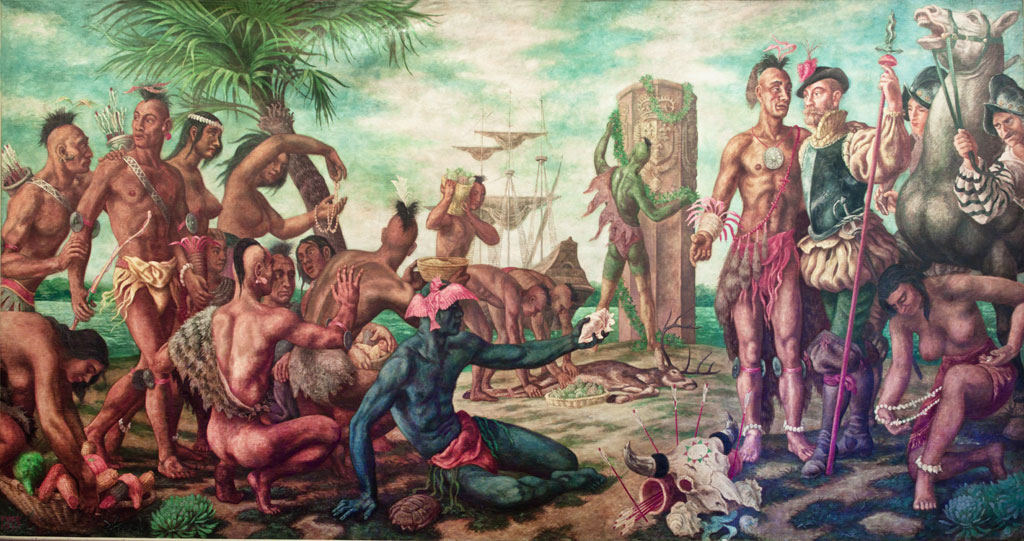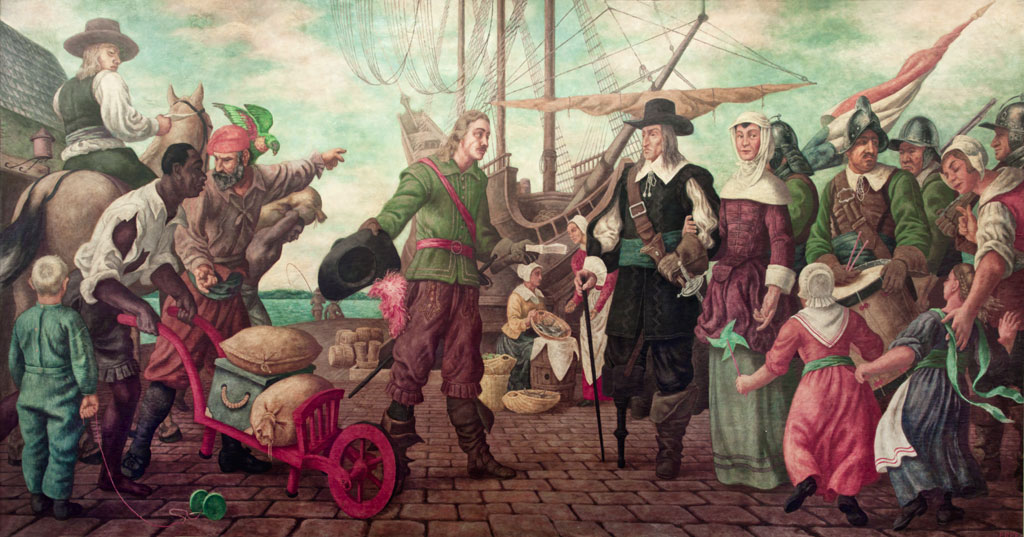Karl Free
French Explorers and Indians
1938
oil on canvas
78 1/2 x 163 in. (199.4 x 414 cm)
Commissioned through the Section of Fine Arts, 1934-1943
FA567B
Photo by Carol M. Highsmith

Arrival of Mail in New Amsterdam
1938
oil on canvas
78 1/2 x 163 in. (199.4 x 414 cm)
Commissioned through the Section of Fine Arts, 1934-1943
FA567A
Photo by Carol M. Highsmith

French Explorers and Indians depicts the June 27, 1564, meeting of French colonists and American Indians. On that date, René Goulaine de Laudonniére, a French Huguenot seeking refuge from persecution in France, landed in what is now Jacksonville, Florida. Upon his arrival, he met Athore, son of chief Saturiwa of the Timucuan American Indian tribe. Their meeting took place at Ribault’s Pillar, a stone monument erected by Laudonniére’s predecessor, Jean Ribault, two years earlier.
The mural features Laudonniére and Athore embracing at the right, while two Huguenots hold Laudonniére’s horse and a Timucuan woman kneels nearby. To the left, Timucuan men and women display fresh produce and wild game, symbols of the land’s bounty, as well as beautiful shells, furs, bows, and arrows. The man painted blue who reclines in the foreground and the man painted green who decorates the pillar with garlands are medicine men, their skin ceremonially tinted with colored clay.
In the years since this mural’s debut, viewers have noted several problems with its portrayal of the Timucuan figures. First, their apparently subservient positions in relation to the French figures; second, the partial nudity of the women; and finally, their clothing and adornments, which mix those of various American Indian tribes. The origins of the mural’s historical inaccuracies are explored below.
Upon their arrival in the New World, in what is today Florida, the French Huguenots established friendly relations with the Timucuan people. In September 1565, the Spanish took over the region. Soon, European diseases decimated many Timucuans. By 1700, the Timucuan population had been reduced to a mere 1,000; by 1763 there were perhaps 125 Timucuans remaining; and by 1938, when Free painted this mural, the Timucuans were considered an extinct tribe. Therefore, Free had no contemporary documentation of the appearance of Timucuan men and women. He did, however, draw very closely on two historical sources.
First, Free based his composition on a 1591 engraving by Theodorus de Bry of a sketch by Jacques Le Moyne, a French artist who was present at the 1564 meeting between Laudonniére and Athore. In the sixteenth century, European artists tended to depict American Indians as dignified and friendly, even subservient, in order to encourage continued exploration of the American continent. Second, Free based the clothing of his Timucuan figures on a set of 1585–86 watercolors by John White that depict the Algonquin people of present-day North Carolina. Both of these sets of images offered rare source material to Free, but neither allowed him to represent the scene with complete accuracy. While history paintings often draw on visual precedents, Free’s murals do so more directly than most. His act of reinterpreting and combining imagery by de Bry, Le Moyne, and White results in a picture that blends his cultural perceptions of the 1930s with the sixteenth-century source material.
Arrival of Mail in New Amsterdam depicts an imagined scene around 1650 in the thriving, multicultural city of New Amsterdam (now New York City), in the Dutch colony of New Netherland. The central figure dressed in black is Peter Stuyvesant, director-general of New Netherland from 1647 to 1664, who strolls near the wharves on the East River with his wife, Judith Bayard. There, he meets Captain Jacob Vandergrift, commander of the Dutch West India Company vessel Zwolle, who removes his hat and gestures toward a cart of mail that has just arrived from Holland. Absent an organized domestic post, mail arriving on American shores from Europe was distributed in town by neighbors and friends. Further inland, it was delivered by merchants and American Indians. Free described the portion of the scene at the left as a townsman asking a farmer to deliver a letter for him to an outlying district. The man pushing the mail cart, who is depicted in a crouched posture with torn clothing, bare feet, and a downward gaze, appears to be African American. At this time in New Amsterdam’s history, many African Americans lived in the city. Initially brought from Africa as slaves of the Dutch West India Company, most became part of the labor force in New Amsterdam that, although not officially codified as slavery, in some ways closely resembled it.
Karl R. Free (1903-1947)
Karl Free was born in Davenport, Iowa, and in 1923 won a scholarship to study at the Art Students League of New York. In the early 1930s, he served as a founding curator of graphic arts at the Whitney Museum of American Art. Although his career was relatively short, Free left behind sketchbooks of his travels throughout Europe, as well as paintings, works on paper, and murals. In 1937, he designed costumes for the Ballet Caravan production of Pocahontas, the designs for which are now at the Museum of Modern Art in New York.
Karl R. Free is one of eleven artists whose murals are featured in the William Jefferson Clinton Federal Building. Access to the Clinton Building is restricted, however tours are available through the U.S. General Services Administration. For more information on the GSA Fine Arts Collection in Washington, D.C., please contact artinfo@gsa.gov.

 U.S. General Services Administration
U.S. General Services Administration


